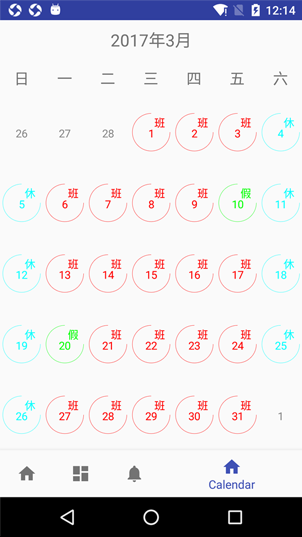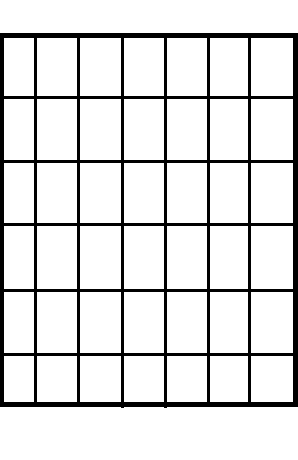您好,登錄后才能下訂單哦!
您好,登錄后才能下訂單哦!
現在網上有很多自定義view實現日歷的demo,今天講一講如何自己實現這個自定義view。
看一下最終效果圖:

在這個自定義view中,我使用了各種奇技淫巧的方法來實現這個日歷,真是費盡心思。廢話少說,開始進坑。
界面分析
頭部是一個textview,顯示年份和月份,然后下邊一行是星期幾,這兩行可以固定住,不隨月份切換而進出屏幕。
再下邊就是我們自定義view 的主角,每個月的天數。目前規定是星期日為每星期第一天。上個月的天數填充滿第一行,下個月的前幾天填充完最后一行,顏色設置為灰色,本月日期中的周一至周五設置為紅色,周六周日設置為青色,特殊日期設置為綠色,并且在右上角填充特殊標識符,用四分之三的圓弧包裹(上個月和下個月的日期沒有)。
此處還有個小細節,每月的總行數會不斷改變,但是view的總高度并未改變,所以視覺效果會不一樣。
構造方法
public MyCalendar(Context context) {
super(context);
}
public MyCalendar(Context context, @Nullable AttributeSet attrs) {
super(context, attrs);
}
主要是實現上面兩個構造方法,第一個是用來在java代碼中使用的,第二個是用來在xml布局文件中使用的。
暴露的接口
目前接口共有下面幾個,setDate(CustomDate customDate),setWeekendHighLight(boolean b),setSpecialDay(int[] ints)
其中第一個是必須要設置的,否則是不會顯示任何東西,第二個設置的是否周末高亮,第三個設置的是特殊顯示的日期,第四個是設置是否可以點擊前一個月或者后一個月的日期,默認為不設置,后期可以根據自己需求增加其他接口。
/**
* 暴露接口,設置日期
*
* @param customDate
*/
public void setDate(CustomDate customDate) {
Log.d(TAG, customDate.toString());
this.date = customDate;
firstDayOfWeek = date.getFirstDayOfWeek();
Log.d(TAG, (date.getMonth() + 1) + "月1號是星期" + firstDayOfWeek);
lastDayOfWeek = date.getLastDayOfWeek();
lineCount = calculateLineNum() + 1;
lastMonthTotalDays = date.getLastMonthDays();
}
/**
* 暴露接口,設置是否周末高亮
*
* @param b
*/
public void setWeekendHighLight(boolean b) {
this.weekendHighlight = b;
}
public void setSpecialDay(int[] ints) {
this.specialDays = ints;
}
/**
* 暴露接口,設置是否可以點擊前一個月和后一個月的日期
*
* @param b
*/
public void setCanClickNextOrPreMonth(boolean b) {
this.canClickNextOrPreMonth = b;
}
在這里說明一下計算顯示行數的方法,首先要注意我們獲取的星期數與實際的星期幾會有一個增加一天的問題,也就是當前是星期4,那么你獲取的int將會是5.
/**
* 獲得應該設置為多少行
*
* @return
*/
private int calculateLineNum() {
monthDaySum = date.getTotalDayOfMonth();
return (firstDayOfWeek - 1 + monthDaySum) / 7;
}
我們將第一天是星期幾減去一后加上這個月總共多少天,就可以獲得最后一天是在什么位置,然后除以七取商的整數部分,然后在進一法即可獲得應該顯示多少行。
onSizechanged方法
onSizechanged方法中已經可以獲得顯示的尺寸了,此時我們需要做一些工作:
protected void onSizeChanged(int w, int h, int oldw, int oldh) {
super.onSizeChanged(w, h, oldw, oldh);
this.viewWidth = w;
this.viewHeight = h;
Log.d(TAG, "onSizeChanged" + w + h);
cutGrid();
init();
setCellDay();
}
首先是將寬和高引入進來,方便后邊使用。
cutGrid()方法是將區域分割為行X列的格式。
init()方法初始化了一些畫筆。
setCellDay()方法將每月的天對應過到坐標上。
首先看一下cutGrid()方法:
/**
* 切分為每天
*/
private void cutGrid() {
cellWidth = (float) viewWidth / ROW_COUNT;
cellHeight = (float) viewHeight / lineCount;
this.radius = Math.min(cellWidth / 2, cellHeight / 2);
for (int i = 0; i < lineCount; i++) {
for (int j = 0; j < ROW_COUNT; j++) {
points.add(new PointF(cellWidth * j + cellWidth / 2, cellHeight * i + cellHeight / 2));
}
}
}
cellWidth是每天的寬度,其中ROW_COUNT是一個常量7,表示每周7天;cellHeight是每行的高度,linecount是一個變量,需要我們根據日期計算,后邊會說到;radius是我們繪制區域的半徑,這個值是我們取寬度和高度中較小的值的一半。然后我們將每個方格中心坐標點利用雙重循環放入一個List<Point> points中。

整個view被分割為如上的形狀。
下面來看一下init()方法:
private void init() {
circlePaint = new Paint();
circlePaint.setStyle(Paint.Style.STROKE);
circlePaint.setAntiAlias(true);
circlePaint.setColor(Color.BLUE);
textPaint = new Paint();
textPaint.setAntiAlias(true);
textPaint.setColor(Color.BLACK);
textPaint.setTextSize(radius / 2);
selectPaint = new Paint();
selectPaint.setColor(Color.YELLOW);
selectPaint.setAlpha(10);
selectPaint.setAntiAlias(true);
selectPaint.setStyle(Paint.Style.FILL);
selectTextPaint = new Paint();
selectTextPaint.setColor(Color.WHITE);
selectTextPaint.setAntiAlias(true);
selectTextPaint.setTextSize(radius / 2);
selectTextPaint.setStyle(Paint.Style.FILL);
}
基本都是畫筆工具。
然后是setAllDays()方法:
/**
* 設置總共顯示多少天,每天的狀態
*/
private void setCellDay() {
cellDays = new CellDay[lineCount * ROW_COUNT];
for (int i = 0, length = cellDays.length; i < length; i++) {
cellDays[i] = new CellDay();
cellDays[i].setPointX(points.get(i).x);
cellDays[i].setPointY(points.get(i).y);
if (firstDayOfWeek > 1 && i < firstDayOfWeek - 1) {
cellDays[i].setDayState(DayState.LASTMONTH);
cellDays[i].setDate(String.valueOf(lastMonthTotalDays - firstDayOfWeek + i + 2));
cellDays[i].setCustomDate(new CustomDate(
date.getYear(), date.getMonth() - 1, lastMonthTotalDays - firstDayOfWeek + i + 2));
}
if (i >= firstDayOfWeek - 1 && i < monthDaySum + firstDayOfWeek - 1) {
cellDays[i].setDayState(CURRENTMONTH);
cellDays[i].setDate(String.valueOf(i + 2 - firstDayOfWeek));
cellDays[i].setCustomDate(new CustomDate(
date.getYear(), date.getMonth(), i - firstDayOfWeek + 2));
//設置周末高亮
if (weekendHighlight) {
if (i % 7 == 0 || i % 7 == 6) {
cellDays[i].setDayState(WEEKEND);
}
}
}
if (i >= monthDaySum + firstDayOfWeek - 1) {
cellDays[i].setDayState(NEXTMONTH);
cellDays[i].setDate(String.valueOf(i - monthDaySum - firstDayOfWeek + 2));
cellDays[i].setCustomDate(new CustomDate(
date.getYear(), date.getMonth() + 1, i - monthDaySum - firstDayOfWeek + 2));
}
for (int j = 0, s = specialDays.length; j < s; j++) {
if (specialDays[j] + firstDayOfWeek - 2 == i) {
cellDays[i].setDayState(SPECIALDAY);
}
}
}
}
在這里我們用到了一個自定的類-CellDay。
CellDay有以下幾個字段
private String date;
private DayState dayState;
private CustomDate customDate;
private float pointX;
private float pointY;
private boolean isSelected;
1、String date表示當前的日期。
2、dayState是一個美劇類型,定義了天的狀態值。
其中可以設置多種狀態,用法和SPECIALDAY基本一樣。
CustomDate工具
public class CustomDate {
private Calendar calendar = Calendar.getInstance(TimeZone.getTimeZone("GMT+8"));
private int year;
private int month;
private int day;
private int dayOfWeek;
public CustomDate() {
}
/**
* 獲取當前的日期
* @return
*/
public CustomDate getCurrentDate() {
this.year = calendar.get(Calendar.YEAR);
this.month = calendar.get(Calendar.MONTH);
this.day = calendar.get(Calendar.DAY_OF_MONTH);
this.dayOfWeek = calendar.get(Calendar.DAY_OF_WEEK);
return new CustomDate(year, month, day);
}
public CustomDate(int year, int month, int day) {
this.year = year;
this.month = month;
this.day = day;
calendar.set(year, month, day);
dayOfWeek = calendar.get(Calendar.DAY_OF_WEEK);
}
/**
* 獲取上個月的天數
* @return
*/
public int getLastMonthDays() {
return this.getDaysOfMonth(this.year, this.month - 1);
}
/**
* 獲取第一天是星期幾
*
* @return
*/
public int getFirstDayOfWeek() {
calendar.set(this.year, this.month, 1);
return calendar.get(Calendar.DAY_OF_WEEK);
}
/**
* 獲取最后一天是星期幾
*
* @return
*/
public int getLastDayOfWeek() {
calendar.set(this.year, this.month, getTotalDayOfMonth());
return calendar.get(Calendar.DAY_OF_WEEK);
}
/**
* 獲取這個月總共的天數
* @return
*/
public int getTotalDayOfMonth() {
return this.getDaysOfMonth(year, month);
}
public int getTotalWeekOfMonth() {
return calendar.getMaximum(Calendar.WEEK_OF_MONTH);
}
public int getYear() {
return year;
}
public void setYear(int year) {
this.year = year;
}
public int getMonth() {
return month;
}
public void setMonth(int month) {
this.month = month;
}
public int getDay() {
return day;
}
public void setDay(int day) {
this.day = day;
}
public int getDayOfWeek() {
return dayOfWeek;
}
public void setDayOfWeek(int dayOfWeek) {
this.dayOfWeek = dayOfWeek;
}
@Override
public String toString() {
return "CustomDate{" +
"year=" + year +
", month=" + (getMonth() + 1) +
", day=" + day +
", dayOfWeek=" + dayOfWeek +
'}';
}
/**
* 獲取年中每月的天數
* @param year
* @param month
* @return
*/
private int getDaysOfMonth(int year, int month) {
if (month > 11) {
month = 0;
year += 1;
} else if (month < 0) {
month = 11;
year -= 1;
}
int[] arr = {31, 28, 31, 30, 31, 30, 31, 31, 30, 31, 30, 31};
int daysOfMonth = 0;
if (year % 4 == 0 && year % 100 != 0 || year % 400 == 0) {
arr[1] = 29;
}
daysOfMonth = arr[month];
return daysOfMonth;
}
}
注釋中對每個方法的說明已經非常清晰了。
int getLastMonthDays()
獲取上個月的天數是用來計算上個月最后一天是星期幾,然后以此推導出上個月在本月中顯示的天數和對應的星期。
getFirstDayOfWeek()
獲取本月第一天是星期幾,然后排序本月的天數與對應的星期。
int getTotalDayOfMonth()
獲取本月總共多少天。配合第一天是星期幾用來計算總共分為幾行,也就是確定linenumber。
以上就是本文的全部內容,希望對大家的學習有所幫助,也希望大家多多支持億速云。
免責聲明:本站發布的內容(圖片、視頻和文字)以原創、轉載和分享為主,文章觀點不代表本網站立場,如果涉及侵權請聯系站長郵箱:is@yisu.com進行舉報,并提供相關證據,一經查實,將立刻刪除涉嫌侵權內容。